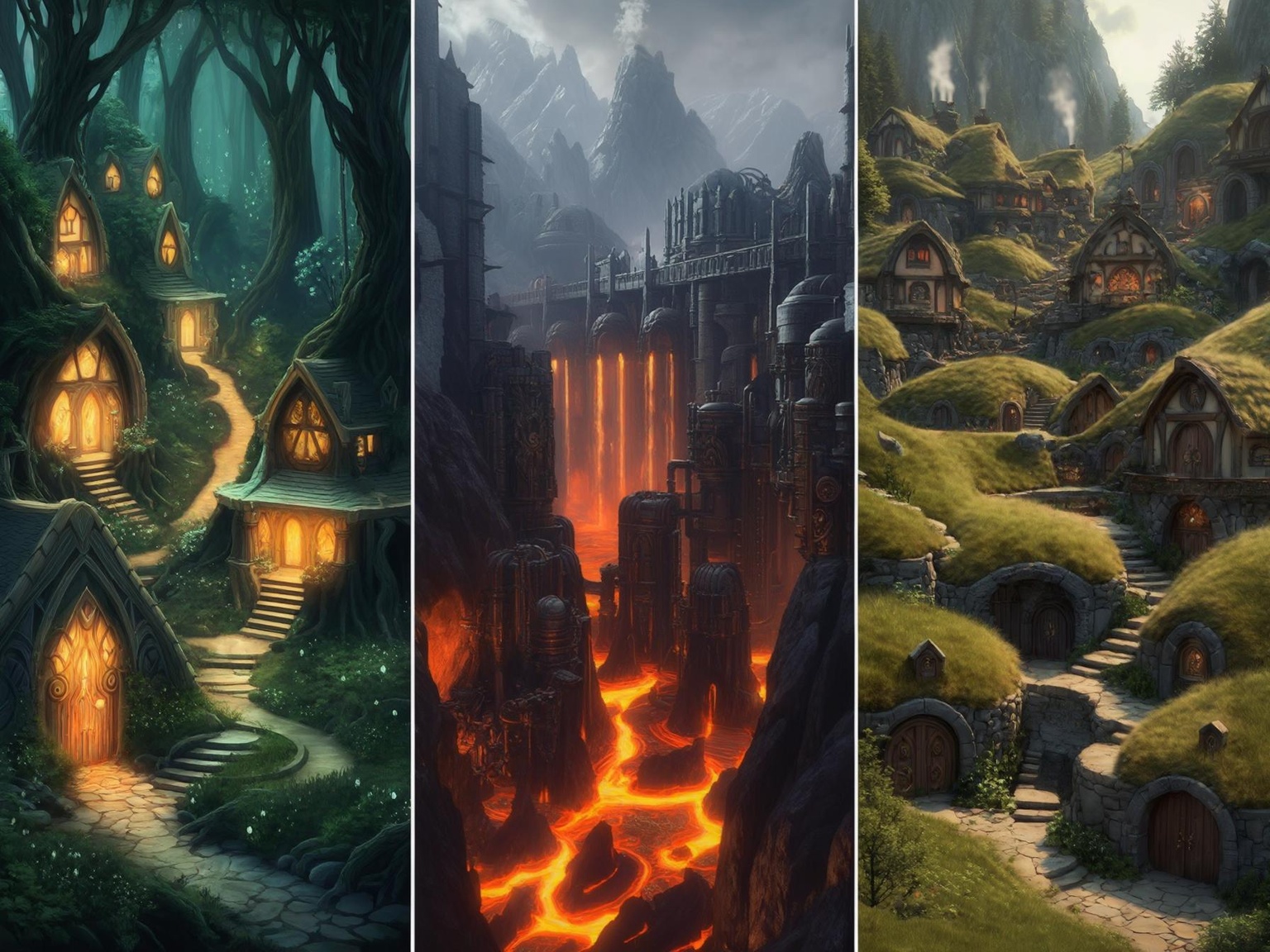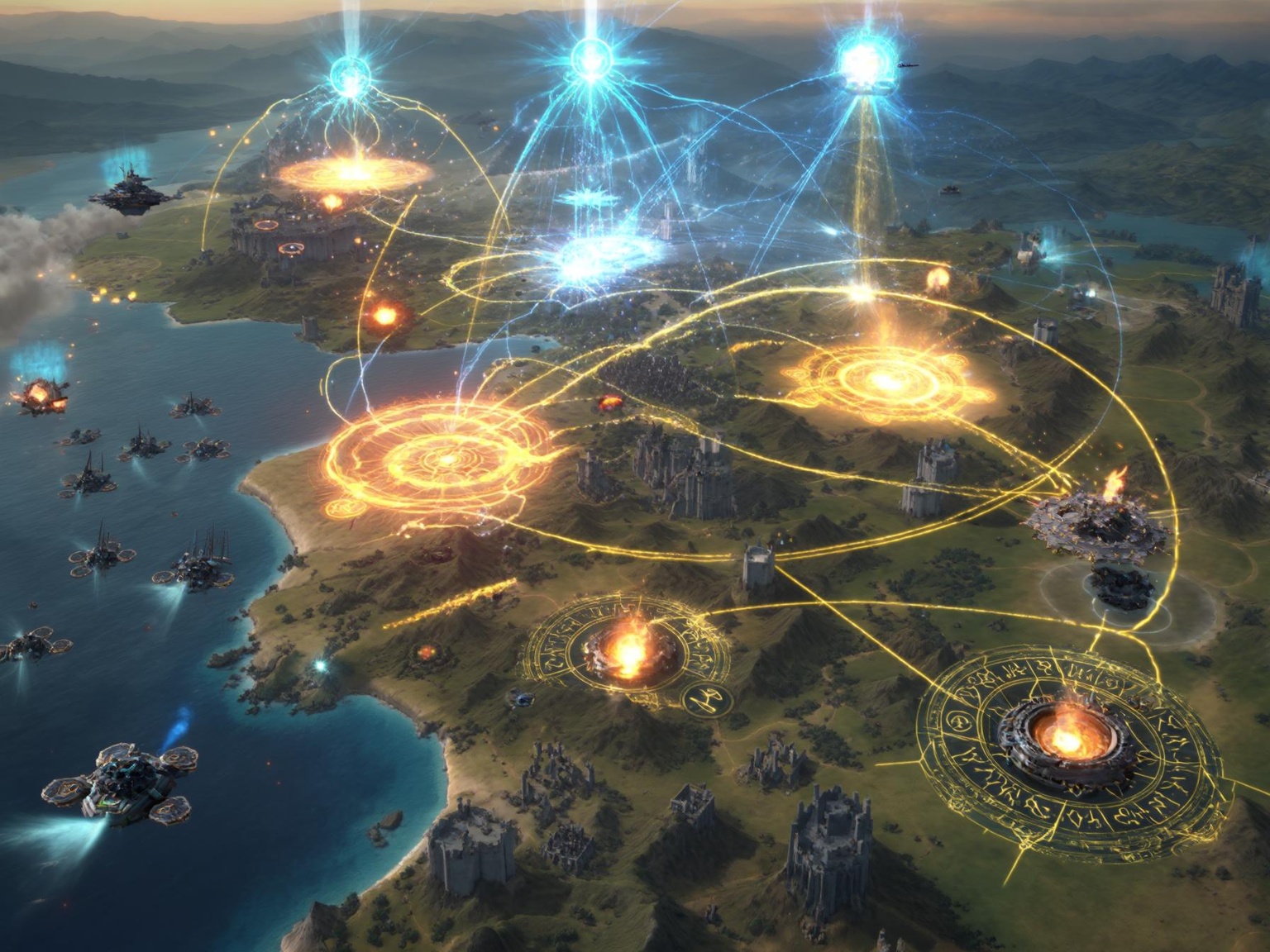From dragon-scorched wastelands to thriving multicultural settlements, Beornan Heafod’s origins reveal how magical intervention shaped a realm’s destiny. The lingering effects of draconic power continue to influence the land’s development and its inhabitants’ daily lives, creating a unique progression system that blends ancient magic with modern civilization.
The Draconic Intervention

Picture a time when Hill Giants and Cyclops waged endless war across these lands. These weren’t just territorial skirmishes – they were civilization-ending conflicts that threatened the very balance of power. The dragons, ancient beings of tremendous power, developed what we’d now recognize as a complete conflict resolution system, albeit one that involved significant collateral damage.
Core Events and Aftermath
The dragons’ solution to the giant-cyclops war demonstrated three essential aspects of their power. First came the gathering – a convergence of multiple dragon flights, each bringing their unique brand of devastating flame. This unprecedented assembly spoke to the severity of the threat these warring races posed.
The scorching itself wasn’t just destruction – it was systematic terraforming. Dragons didn’t simply burn the land; they reshaped it entirely, creating what would become the Dead Dunelands. This stark reminder of their intervention serves as a permanent status effect on the region, influencing everything from local climate to magical resonance.
Magical Phenomena and Environmental Effects

The aftermath of the dragon intervention created unique magical zones throughout the realm. The Dead Dunelands, for instance, exhibit unusual magical properties that affect spellcasting and enchantment durability. Adventurers report that certain spells become more powerful within these areas, while others fail completely, creating a dynamic magic system that requires careful adaptation.
Dragon-touched areas throughout Beornan Heafod demonstrate distinct magical signatures. The crystalline formations in the northern reaches still pulse with residual dragon energy, creating natural magical enhancement zones. These areas have become highly sought after by mages and artificers seeking to harness their power for enchantment and magical research.
What’s particularly fascinating is how these dragon-touched zones continue to evolve. The Shimmerfields, once barren wasteland, now produce crops with inherent magical properties. The Eternamist Valley generates self-sustaining fog banks that enhance certain types of divination magic. Even the seemingly desolate Crystal Wastes harbor unique magical crystalline formations that respond to moonlight, creating natural magical energy reservoirs.
Seasonal Magical Fluctuations
Dragon magic doesn’t remain static – it pulses with the seasons, creating what amounts to a dynamic environmental buff system. During the summer solstice, the Dead Dunelands actually bloom with mysterious fire-flowers, their petals containing concentrated magical essence. Winter brings the Frost Resonance, when dragon-touched areas emit harmonic frequencies that enhance ice-based magic.
These seasonal changes force settlements and adventurers alike to adapt their strategies throughout the year. Some communities have developed entire calendars based on magical fluctuations, timing their major activities to coincide with beneficial magical conditions.
The Human Settlement Phase
When humans first arrived at these shores, they encountered a land that had essentially reset its progression tree. The dragons’ intervention had wiped clean the slate, creating optimal conditions for new civilizations to establish themselves.
Settlement Mechanics and Early Challenges
Cynings Island represents what we’d now call a perfect starting zone – naturally defensible, resource-rich, and strategically positioned. The construction of Salvus Hus wasn’t just architecture; it was the establishment of a permanent spawn point for human civilization in these lands.
The early settlers quickly discovered that dragon-affected territories required specialized building techniques. They developed unique architectural styles that incorporated magical warding systems into their foundations, creating settlements that could withstand both natural and supernatural threats.
Advanced Settlement Integration
These early innovations led to the development of what we now call “resonance architecture” – buildings that actually grow stronger over time as they absorb ambient magical energy from the dragon-touched land. This system creates a fascinating progression mechanic where older structures often possess unexpected magical properties and enhanced durability.
The most successful settlements learned to incorporate dragon-touched materials into their construction. The famous Spellward Towers of Salvus Hus use foundation stones quarried from areas of high magical resonance, creating natural energy conduits that power the city’s defensive systems. Similar techniques spread throughout the kingdom, leading to a architectural renaissance that blended magical efficiency with defensive capability.
Multicultural Development and Racial Specialization
What makes Beornan Heafod truly unique is its faction system. Each race found its ideal starting location: elves in Seolfur Wudu, dwarves in Ferrum Mons, and halflings in Hyden Seir. These weren’t random choices but carefully selected zones that matched each race’s natural affinities and gameplay preferences.
Specialized Racial Advancement Trees

Each race developed specialized techniques for thriving in their chosen territories. The elves of Seolfur Wudu created an intricate system of magical pathways through their forest domain, effectively turning the entire woodland into a sophisticated defense and transportation network. Their progression system focuses heavily on natural attunement and magical enhancement.
Dwarven settlers in Ferrum Mons pioneered new mining techniques that could safely extract resources from dragon-touched stone. Their technological advancement tree became increasingly sophisticated, blending traditional crafting with magical innovation. The results can be seen in their legendary forge-works, which produce items with unique magical properties.
The halflings of Hyden Seir developed perhaps the most interesting adaptation system. Their settlements feature innovative stealth mechanics that make entire villages seemingly disappear into the landscape. This isn’t simple camouflage – it’s a complex combination of magical concealment and architectural ingenuity that improves with each generation.
Cross-Cultural Innovation
As these races developed their specialties, they began to share knowledge in unexpected ways. Dwarven metallurgy combined with elven nature magic led to the creation of living metal – alloys that could actually grow and adapt to their environment. Halfling stealth techniques, when applied to dwarven mining operations, revolutionized the way valuable resources could be extracted from dangerous areas.
These collaborations went beyond simple technology sharing. The Triune Temples, for instance, combine architectural elements from all three races to create structures that can channel and store magical energy with unprecedented efficiency. Such innovations demonstrate how cultural exchange can lead to exponential advancement in magical capability.
The Dynamic Threat System
Modern Beornan Heafod maintains what amounts to a dynamic threat generation system. Orc raids, hobgoblin incursions, and goblin attacks create constant challenges that keep settlements on their toes. This persistent danger mechanic drives technological advancement and encourages inter-racial cooperation.
Advanced Defense Networks and Response Systems

The kingdom’s response to persistent threats led to the development of sophisticated warning and defense systems. Border settlements established magical beacon networks that could instantly alert nearby communities of incoming dangers. These networks have evolved into complex communication systems that serve both defensive and commercial purposes.
Frontier towns developed what we’d recognize as adaptive AI in their defense planning. Their strategies evolve based on attack patterns, with settlements sharing information about raider tactics and effective countermeasures. This creates a fascinating meta-progression system where defensive capabilities improve kingdom-wide in response to new threats.
Technological Integration and Innovation
The constant pressure of external threats has driven remarkable technological advancement. The Wardstone Network, a kingdom-wide system of enchanted markers, provides early warning of large-scale hostile movement. The Spellfire Beacons can transmit messages across vast distances, coordinating defensive responses with unprecedented speed.
Perhaps most impressive is the development of mobile defense platforms – enchanted structures that can be rapidly deployed to reinforce threatened areas. These innovations demonstrate how necessity drives magical and technological progress, creating systems that would be impossible without the combined knowledge of multiple races.
Unity Through Adversity and Cultural Integration
The kingdom’s response to these threats showcases a sophisticated alliance system. Different races, each with their unique abilities and cultural bonuses, must work together to maintain the realm’s security. This cooperation creates deep gameplay mechanics that reward diverse party composition and strategic thinking.
Advanced Cultural Exchange Systems
The necessity of cooperation against common threats led to the development of interesting cross-cultural progression systems. Mixed settlements began to emerge, combining the unique strengths of different races. These communities often develop hybrid technologies and magical techniques that wouldn’t be possible within a single cultural tradition.
Trading hubs became centers of cultural exchange, where knowledge and techniques from different races could be shared and combined. This created what amounts to a skill-sharing system, where practitioners can learn and adapt techniques from other races, leading to unique hybrid builds and specializations.
Hybrid Development Paths
Modern adventurers in Beornan Heafod can access multiple progression paths, each influenced by the realm’s rich history. The emergence of hybrid classes and specializations demonstrates how the kingdom’s diverse heritage creates unique opportunities for character development.
Contemporary Magical Innovation

Today’s Beornan Heafod demonstrates how historical events can shape contemporary advancement mechanics. The lingering effects of dragon magic, combined with centuries of multicultural development, have created a unique environment where traditional fantasy elements merge seamlessly with RPG-style progression.
Modern Application of Ancient Powers
Contemporary mages and artificers continue to discover new applications for dragon-touched materials and energies. The Academy of Hybrid Arts specializes in combining different magical traditions, creating entirely new schools of magic that build upon the kingdom’s diverse heritage.
Recent innovations include the development of resonance crystals that can store and amplify magical energy, portable wardstones that provide temporary safe zones in dangerous areas, and enchanted communication devices that work reliably even in magically turbulent regions.
Future Developments and Ongoing Research
As Beornan Heafod continues to evolve, new possibilities emerge for magical and technological advancement. Researchers study the long-term effects of dragon magic on the environment, seeking ways to harness these changes for the benefit of all races. The kingdom’s unique blend of cultures and traditions ensures that innovation will continue, driven by the combined knowledge and creativity of its diverse population.
Ready to explore your own path through Beornan Heafod’s history? Begin your journey where dragons once ruled and discover how ancient conflicts shaped modern adventures.

